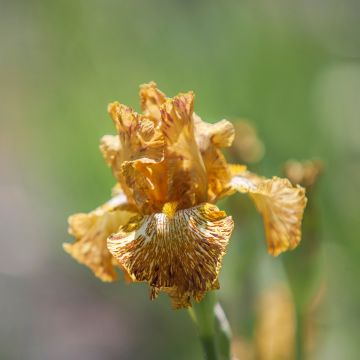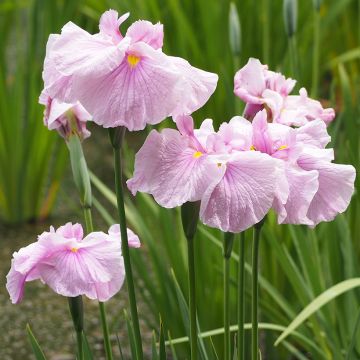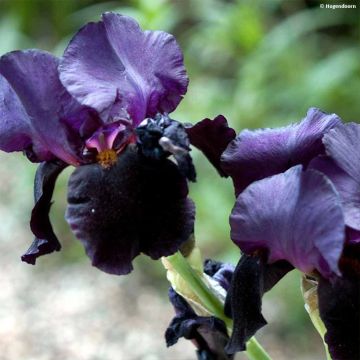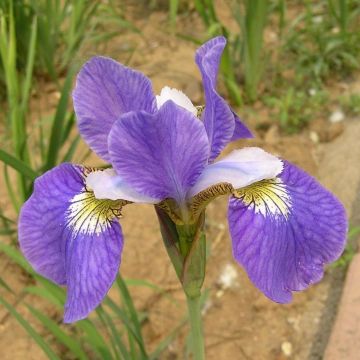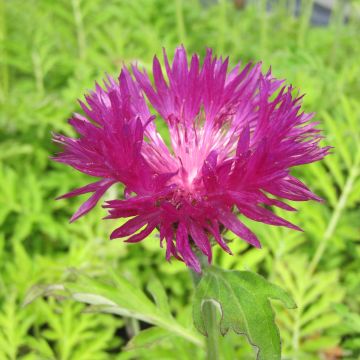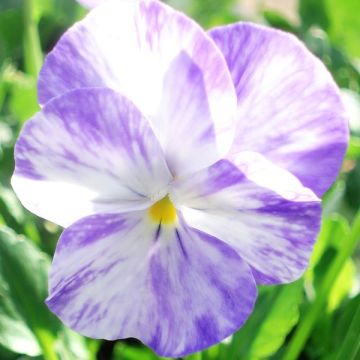

Iris pallida Variegata - Sweet Iris
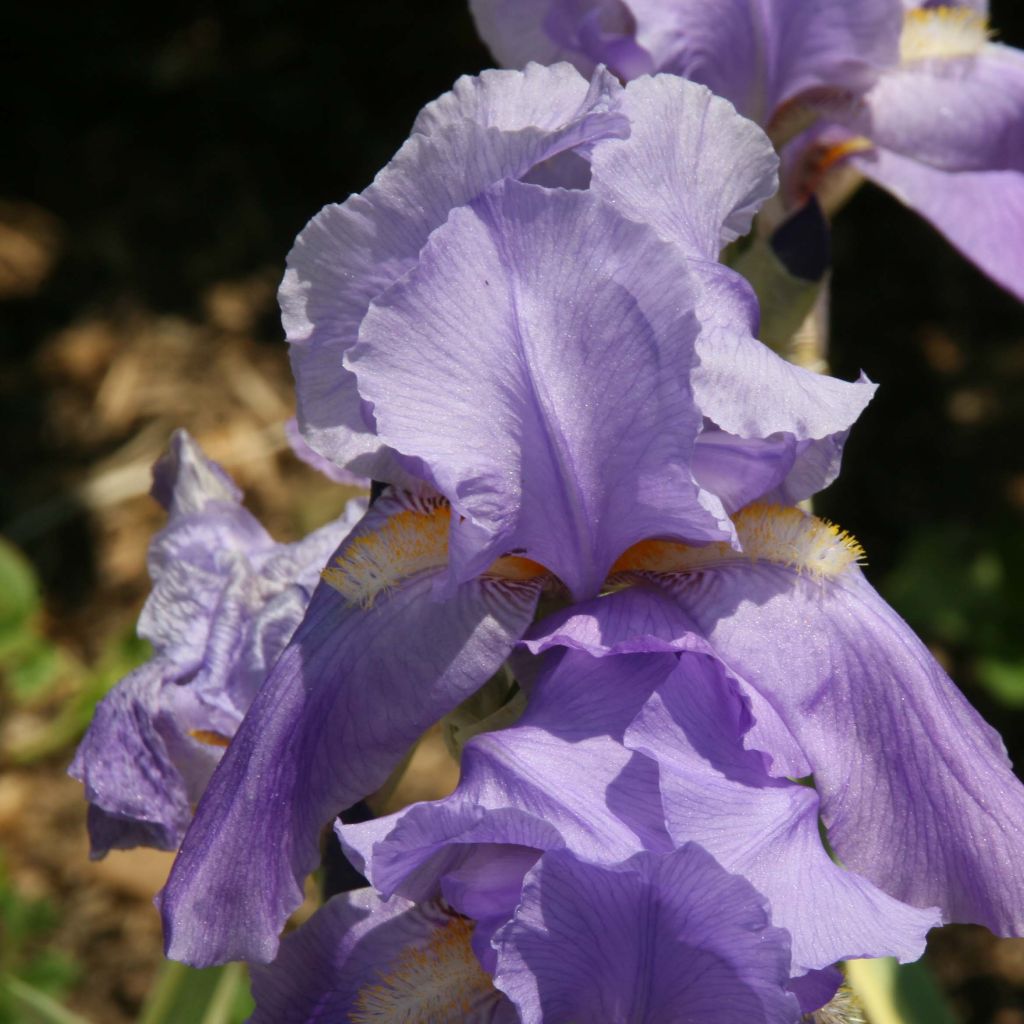

Iris pallida Variegata - Sweet Iris
Iris pallida Variegata - Sweet Iris
Iris pallida Variegata
Sweet Iris, Dalmatian Iris, Pale Iris
The young plants arrived rotten with a strong smell. The interior of its container was soaked. Only one young plant survived after two days.
Greg, 18/05/2023
This item cannot be shipped to the selected country
Delivery charge from €5.90
Delivery charge from €5.90
More information
Schedule delivery date,
and select date in basket
This plant carries a 12 months recovery warranty
More information
We guarantee the quality of our plants for a full growing cycle, and will replace at our expense any plant that fails to recover under normal climatic and planting conditions.
From €5.90 for pickup delivery and €6.90 for home delivery
Express home delivery from €8.90.
From €5.90 for pickup delivery and €6.90 for home delivery
Express home delivery from €8.90.
Does this plant fit my garden?
Set up your Plantfit profile →
Description
Iris pallida Variegata with bright green foliage variegated with yellow and cream, is a very beautiful form of this perennial, also known as Pale Iris. This plant is ornamental even when not in flower and similar to our garden irises with large rhizomes and big puffy flowers. But it blooms longer in spring, and has a delicate fragrance. Its flowers are simple and of moderate size, a crystalline lavender blue, warmed by a golden to orange throat. It is an excellent garden plant that will adapt to all climates and dry summers but prefers limestone. A bright, sculptural, easy-to-grow iris that will even please those who generally don't like irises.
The Pale Iris is an upright, deciduous rhizomatous perennial of the iris family. Its origins are found in rocky areas of Mediterranean and sub-Mediterranean regions, up to higher altitudes in Montenegro. This species gets its other name, Iris of Dalmatia, from its native region, which includes the coastal areas of Croatia and the Adriatic Sea, from Herzegovina to Bosnia. Iris pallida should not be confused with the Florentine Iris (Iris florentina or pallida Ten.), with white flowers, whose dried rhizomes are used in perfumery. The Iris of Dalmatia can be recognized by a papery, silvery sheath enclosing the base of its flowers, which resembles tissue paper.
The well-known 'Variegata' form may be a spontaneous mutation of this botanical species. it is a bit smaller, 70 cm (28in) high when flowering. Each rhizome produces one to two solid, branched flower stalks, from March to June depending on the climate. Each flower stalk has a total of 5 to 9 flowers. They open successively or in pairs, from dark blue twisted buds, over the course of 4 to 5 weeks. The flowers consist of 3 upright petals dominating 3 drooping sepals. Each sepal has a yellow to orange beard in the golden throat of the flower. Their size varies from 5 to 10 cm (2 to 4in) in diameter and they are bright lavender blue. The fragrance is typical of iris, sweet and powdery.
Iris pallida Variegata spreads fairly quickly, with no theoretical limit over time, with the central rhizomes becoming bare in favour of the outer rhizomes. The foliage is long swords, 20 to 50 cm (8 to 20in), with prominent veins, traversed along their entire length by large yellowish streaks on a green background that also takes on different, glaucous or vibrant shades. The vegetation disappears in winter, leaving only the rhizomes on the surface of the soil.
To accompany irises, choose plants that thrive in the sun and dry soil, preferably low-growing or with light foliage so as not to cast shade on them, and consider their decorative appearance and flowering time. Gaura, for example, meets these criteria, and its later flowering will keep the bed attractive in summer. California poppies, perennial geraniums, salvias, and ixias also complement irises very well. Tall irises can be used against a wall, relatively sheltered from the wind. They can also be planted in the foreground of shorter and earlier varieties. The vegetable garden can be adorned with a few clumps or borders of irises for cutting. The particularly bright Iris pallida Variegata will be highlighted if planted en masse along a pathway or in a large rockery.
Iris pallida, even more than Iris germanica, is the ancestor of our modern irises: it has been used by horticulturists since early hybridization and selection work. Its Plicata form, discovered in 1612 is shorter and bears smaller but speckled flowers, and is the origin of many horticultural varieties classified in the 'plicata' type.
Report an error about the product description
Iris pallida Variegata - Sweet Iris in pictures


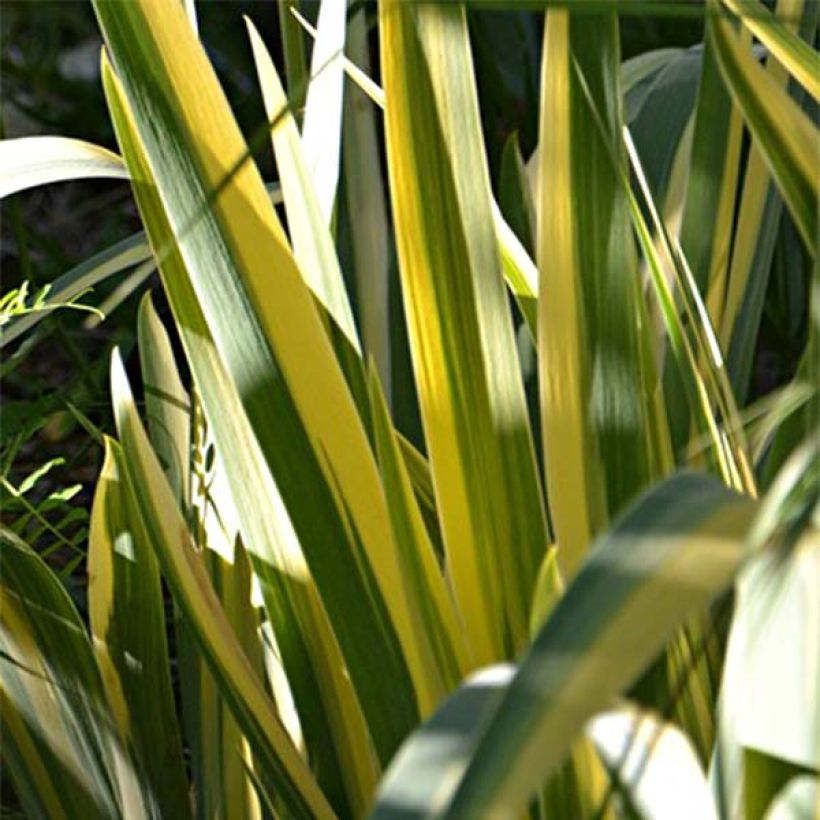



Flowering
Foliage
Plant habit
Botanical data
Iris
pallida
Variegata
Iridaceae
Sweet Iris, Dalmatian Iris, Pale Iris
Mediterranean
Other Iris A to Z
Planting and care
Do you have a very sunny location,rather dry in summer?
This is the ideal location for irises! In the shade, they grow but do not bloom. They are hardy and do not need winter protection. Well-drained soil is perfect, even dry and chalky, or rocky. Too much moisture promotes rhizome rot. Plant from July to September to allow the rhizomes to grow sufficiently before being and develop new roots before winter. They should be planted as soon as they are purchased for the best results. Plan to divide the irises every 4 years or so to give them fresh soil. They are vigorous and require space to develop and flower well. Plant with a spacing appropriate to the size and vigour of the variety: about 34-50 cm (13-20in) for tall ones. Always consider the direction of growth of the rhizomes by arranging them in a star shape, with buds and leaves facing outward, and spacing them well away from other varieties so they have room to develop.
Planting
Dig a hole that is wide and deep enough. Make a conical mound of soil in the hole, on which to place the rhizome and spread out the roots. Cover the roots. The rhizome must be level with the surface of the soil. It should not be planted in a dip (risk of rot), so take into account that the soil will settle and the iris will sink. In clay or moist soil, the rootstock can even be raised on a slight mound. To make the soil cling to the roots, gently firm and water abundantly after planting. Water 2-3 times if necessary until the plant takes root.
Maintenance:
Keep the soil free of weeds by lightly hoeing, taking care not to damage the rhizomes or roots. Weeds cast shade on the irises, retain moisture (which can cause rot), and attract slugs. Likewise, remove dry leaves. If they are diseased (reddish-brown bordered spots of heterosporiosis), we recommend burning them. Remove faded flowers.
Planting period
Intended location
Care
-
, onOrder confirmed
Reply from on Promesse de fleurs
Spring flowering perennials
Haven't found what you were looking for?
Hardiness is the lowest winter temperature a plant can endure without suffering serious damage or even dying. However, hardiness is affected by location (a sheltered area, such as a patio), protection (winter cover) and soil type (hardiness is improved by well-drained soil).

Photo Sharing Terms & Conditions
In order to encourage gardeners to interact and share their experiences, Promesse de fleurs offers various media enabling content to be uploaded onto its Site - in particular via the ‘Photo sharing’ module.
The User agrees to refrain from:
- Posting any content that is illegal, prejudicial, insulting, racist, inciteful to hatred, revisionist, contrary to public decency, that infringes on privacy or on the privacy rights of third parties, in particular the publicity rights of persons and goods, intellectual property rights, or the right to privacy.
- Submitting content on behalf of a third party;
- Impersonate the identity of a third party and/or publish any personal information about a third party;
In general, the User undertakes to refrain from any unethical behaviour.
All Content (in particular text, comments, files, images, photos, videos, creative works, etc.), which may be subject to property or intellectual property rights, image or other private rights, shall remain the property of the User, subject to the limited rights granted by the terms of the licence granted by Promesse de fleurs as stated below. Users are at liberty to publish or not to publish such Content on the Site, notably via the ‘Photo Sharing’ facility, and accept that this Content shall be made public and freely accessible, notably on the Internet.
Users further acknowledge, undertake to have ,and guarantee that they hold all necessary rights and permissions to publish such material on the Site, in particular with regard to the legislation in force pertaining to any privacy, property, intellectual property, image, or contractual rights, or rights of any other nature. By publishing such Content on the Site, Users acknowledge accepting full liability as publishers of the Content within the meaning of the law, and grant Promesse de fleurs, free of charge, an inclusive, worldwide licence for the said Content for the entire duration of its publication, including all reproduction, representation, up/downloading, displaying, performing, transmission, and storage rights.
Users also grant permission for their name to be linked to the Content and accept that this link may not always be made available.
By engaging in posting material, Users consent to their Content becoming automatically accessible on the Internet, in particular on other sites and/or blogs and/or web pages of the Promesse de fleurs site, including in particular social pages and the Promesse de fleurs catalogue.
Users may secure the removal of entrusted content free of charge by issuing a simple request via our contact form.
The flowering period indicated on our website applies to countries and regions located in USDA zone 8 (France, the United Kingdom, Ireland, the Netherlands, etc.)
It will vary according to where you live:
- In zones 9 to 10 (Italy, Spain, Greece, etc.), flowering will occur about 2 to 4 weeks earlier.
- In zones 6 to 7 (Germany, Poland, Slovenia, and lower mountainous regions), flowering will be delayed by 2 to 3 weeks.
- In zone 5 (Central Europe, Scandinavia), blooming will be delayed by 3 to 5 weeks.
In temperate climates, pruning of spring-flowering shrubs (forsythia, spireas, etc.) should be done just after flowering.
Pruning of summer-flowering shrubs (Indian Lilac, Perovskia, etc.) can be done in winter or spring.
In cold regions as well as with frost-sensitive plants, avoid pruning too early when severe frosts may still occur.
The planting period indicated on our website applies to countries and regions located in USDA zone 8 (France, United Kingdom, Ireland, Netherlands).
It will vary according to where you live:
- In Mediterranean zones (Marseille, Madrid, Milan, etc.), autumn and winter are the best planting periods.
- In continental zones (Strasbourg, Munich, Vienna, etc.), delay planting by 2 to 3 weeks in spring and bring it forward by 2 to 4 weeks in autumn.
- In mountainous regions (the Alps, Pyrenees, Carpathians, etc.), it is best to plant in late spring (May-June) or late summer (August-September).
The harvesting period indicated on our website applies to countries and regions in USDA zone 8 (France, England, Ireland, the Netherlands).
In colder areas (Scandinavia, Poland, Austria...) fruit and vegetable harvests are likely to be delayed by 3-4 weeks.
In warmer areas (Italy, Spain, Greece, etc.), harvesting will probably take place earlier, depending on weather conditions.
The sowing periods indicated on our website apply to countries and regions within USDA Zone 8 (France, UK, Ireland, Netherlands).
In colder areas (Scandinavia, Poland, Austria...), delay any outdoor sowing by 3-4 weeks, or sow under glass.
In warmer climes (Italy, Spain, Greece, etc.), bring outdoor sowing forward by a few weeks.



































